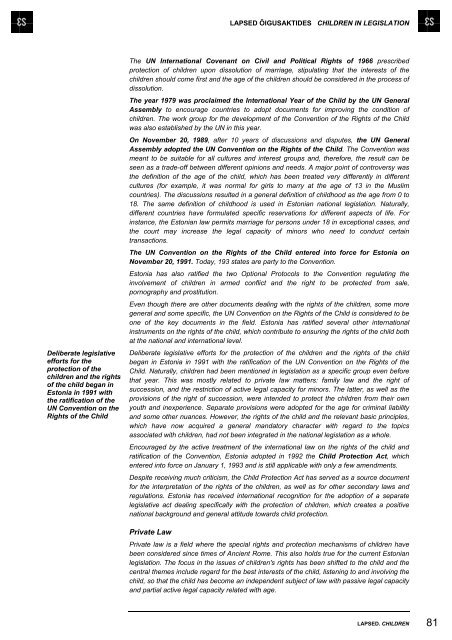LAPSED CHILDREN - Tartu Ãlikool
LAPSED CHILDREN - Tartu Ãlikool
LAPSED CHILDREN - Tartu Ãlikool
- No tags were found...
Create successful ePaper yourself
Turn your PDF publications into a flip-book with our unique Google optimized e-Paper software.
<strong>LAPSED</strong> ÕIGUSAKTIDES <strong>CHILDREN</strong> IN LEGISLATION<br />
Deliberate legislative<br />
efforts for the<br />
protection of the<br />
children and the rights<br />
of the child began in<br />
Estonia in 1991 with<br />
the ratification of the<br />
UN Convention on the<br />
Rights of the Child<br />
The UN International Covenant on Civil and Political Rights of 1966 prescribed<br />
protection of children upon dissolution of marriage, stipulating that the interests of the<br />
children should come first and the age of the children should be considered in the process of<br />
dissolution.<br />
The year 1979 was proclaimed the International Year of the Child by the UN General<br />
Assembly to encourage countries to adopt documents for improving the condition of<br />
children. The work group for the development of the Convention of the Rights of the Child<br />
was also established by the UN in this year.<br />
On November 20, 1989, after 10 years of discussions and disputes, the UN General<br />
Assembly adopted the UN Convention on the Rights of the Child. The Convention was<br />
meant to be suitable for all cultures and interest groups and, therefore, the result can be<br />
seen as a trade-off between different opinions and needs. A major point of controversy was<br />
the definition of the age of the child, which has been treated very differently in different<br />
cultures (for example, it was normal for girls to marry at the age of 13 in the Muslim<br />
countries). The discussions resulted in a general definition of childhood as the age from 0 to<br />
18. The same definition of childhood is used in Estonian national legislation. Naturally,<br />
different countries have formulated specific reservations for different aspects of life. For<br />
instance, the Estonian law permits marriage for persons under 18 in exceptional cases, and<br />
the court may increase the legal capacity of minors who need to conduct certain<br />
transactions.<br />
The UN Convention on the Rights of the Child entered into force for Estonia on<br />
November 20, 1991. Today, 193 states are party to the Convention.<br />
Estonia has also ratified the two Optional Protocols to the Convention regulating the<br />
involvement of children in armed conflict and the right to be protected from sale,<br />
pornography and prostitution.<br />
Even though there are other documents dealing with the rights of the children, some more<br />
general and some specific, the UN Convention on the Rights of the Child is considered to be<br />
one of the key documents in the field. Estonia has ratified several other international<br />
instruments on the rights of the child, which contribute to ensuring the rights of the child both<br />
at the national and international level.<br />
Deliberate legislative efforts for the protection of the children and the rights of the child<br />
began in Estonia in 1991 with the ratification of the UN Convention on the Rights of the<br />
Child. Naturally, children had been mentioned in legislation as a specific group even before<br />
that year. This was mostly related to private law matters: family law and the right of<br />
succession, and the restriction of active legal capacity for minors. The latter, as well as the<br />
provisions of the right of succession, were intended to protect the children from their own<br />
youth and inexperience. Separate provisions were adopted for the age for criminal liability<br />
and some other nuances. However, the rights of the child and the relevant basic principles,<br />
which have now acquired a general mandatory character with regard to the topics<br />
associated with children, had not been integrated in the national legislation as a whole.<br />
Encouraged by the active treatment of the international law on the rights of the child and<br />
ratification of the Convention, Estonia adopted in 1992 the Child Protection Act, which<br />
entered into force on January 1, 1993 and is still applicable with only a few amendments.<br />
Despite receiving much criticism, the Child Protection Act has served as a source document<br />
for the interpretation of the rights of the children, as well as for other secondary laws and<br />
regulations. Estonia has received international recognition for the adoption of a separate<br />
legislative act dealing specifically with the protection of children, which creates a positive<br />
national background and general attitude towards child protection.<br />
Private Law<br />
Private law is a field where the special rights and protection mechanisms of children have<br />
been considered since times of Ancient Rome. This also holds true for the current Estonian<br />
legislation. The focus in the issues of children's rights has been shifted to the child and the<br />
central themes include regard for the best interests of the child, listening to and involving the<br />
child, so that the child has become an independent subject of law with passive legal capacity<br />
and partial active legal capacity related with age.<br />
<strong>LAPSED</strong>. <strong>CHILDREN</strong> 81

















